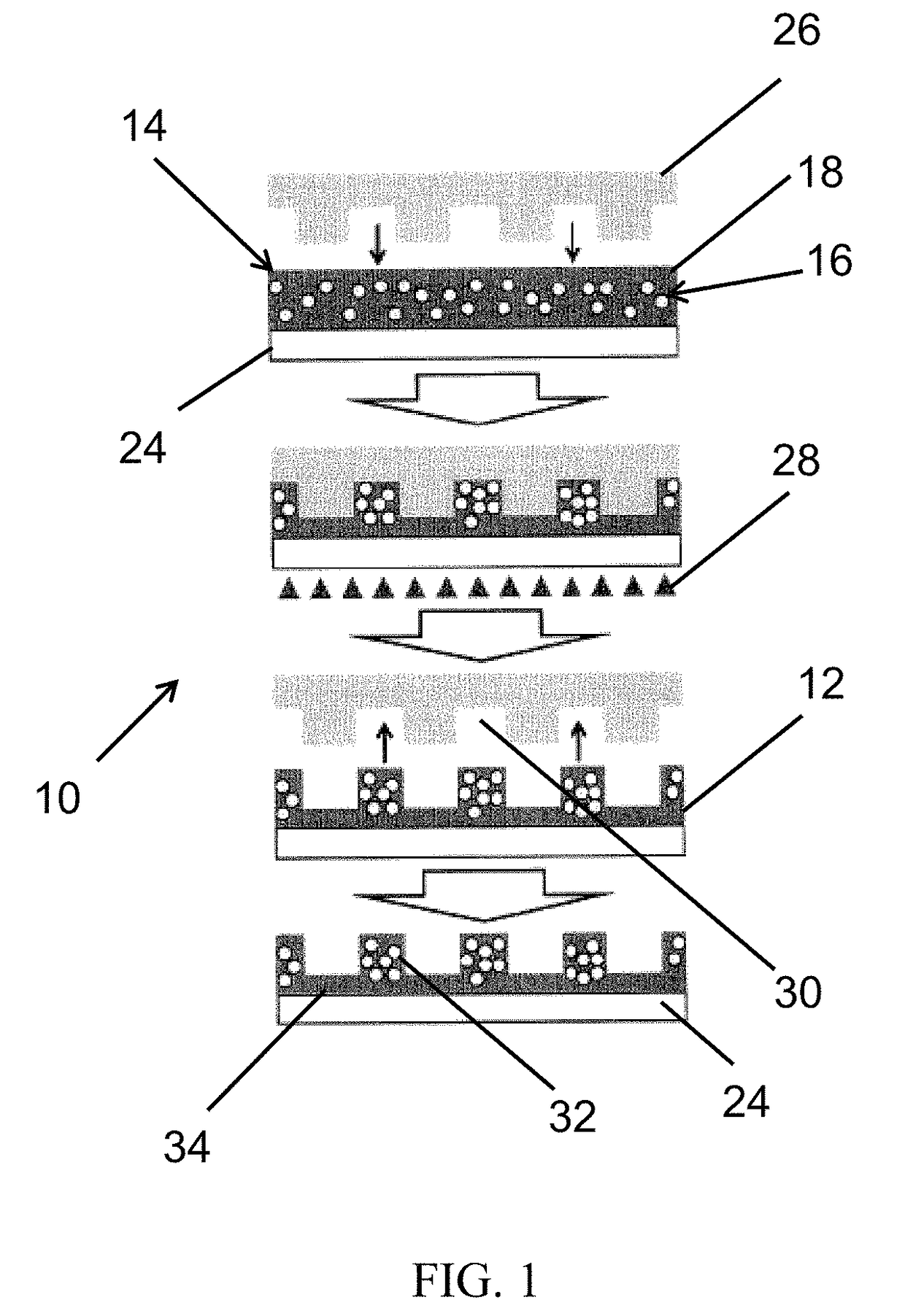Fabrication of patterned nanoparticle structures
a nanoparticle and nanoparticle technology, applied in material nanotechnology, nanotechnology, titanium dioxide, etc., can solve the problems of limited nanoscale resolution, long time, and limited current knowledge techniques
- Summary
- Abstract
- Description
- Claims
- Application Information
AI Technical Summary
Benefits of technology
Problems solved by technology
Method used
Image
Examples
example 1
[0089]Materials:
[0090]Thiol-polystyrene (PS-SH) grafted gold nanoparticles (AuPS) were synthesized by phase transfer reduction of [AuCl4] in the presence of thiol ligands. The average radius of the gold core was about 1.2 nm. PS grafting density was 0.7 / nm2. The molecular weight of grafted PS chains was 11.5 kg / mol. Poly (methyl methacrylate) (PMMA, Mn,PMMA=3.1 kg / mol, polydispersity=1.09) were purchased from Polymer Source Inc. and used as obtained.
[0091]Mask Fabrication:
[0092]Topographically patterned cross-linked poly (dimethyl siloxane) (PDMS) elastomer mold was made using Slygard 184 with a curing agent to base ratio of 1:20. After mixing and degassing, PDMS was cured on a channel patterned polycarbonate substrate from a commercial DVD disk (DVD, pitch λ=750 nm, amplitude A=120 nm) at 120° C. for 6 h to generate a channel patterned PDMS mold. Alternatively, a partially cured channel patterned PDMS was applied on another fully cured channel patterned PDMS to fabricate a cross-ha...
example 2
[0099]Materials:
[0100]Polystyrene (PS) with different molecular masses were purchased from Polymer Source Inc. and used as obtained (PS 3k, Mn,PS=2.8 kg / mol, PDI=1.09; PS 4k, Mn,PS=4.8 kg / mol, PDI=1.07; PS 6k, Mn,PS=6.1 kg / mol, PDI=1.05; PS 16k, Mn,PS=16 kg / mol, PDI=1.03; PS 160k, Mn,PS=160 kg / mol, PDI=1.05; PS 360k, Mn,PS=360 kg / mol, PDI=1.09.) Thiol-polystyrene (PS-SH) grafted gold nanoparticles (AuPS) were synthesized by phase transfer reduction of [AuCl4] in the presence of thiol ligands. The average radius of gold core R0 was 1.2±0.4 nm. The grafted PS molecular mass was Mn,PS,grafted=11.5 kg / mol and the grafting density (σ) was 0.7 / nm2. Upon vacuum oven annealing at 180° C. for 16 h, AuPS nanoparticles experienced subtle size increase to R0 of 1.3±0.5 nm due to the thermal instability of thiol-Au bond. The average radius of SiO2 core was R0 of 7.7±2.1 nm, grafted with PS chains with Mn,PS=54 kg / mol at grafting density of 0.57 / nm2. The PS-g-SiO2 particles were synthesized by su...
example 3
[0110]Materials:
[0111]Blend thin films composed of PS-g-TiO2 nanoparticles in polystyrene (PS) matrix and PMMA-g-TiO2 nanoparticles in PMMA matrix were studied. PS (Mn,PS=2.8 kg / mol, PDI=1.09) and PMMA (Mn,PMMA=3.1 kg / mol, polydispersity=1.09) were purchased from Polymer Source Inc. and used as obtained. The average diameter of the bare TiO2 particle core is D0=24±1 nm with a grafting density σ of about 0.61 chains / nm2. The number average molecular mass of the grafted PS ligands is Mn,PS=15 kg / mol. The TiO2 particles were synthesized using a ‘grafting to’ approach as generally known. The solvent used in this study was toluene, purchased originally from Fisher Scientific (Certified ACS; ≧99.5%). Poly (4-styrenesulfonic acid) (PSS), 18 wt % solution in water was purchased from Aldrich Chemistry and dissolved in isopropyl alcohol (IPA) to make 1 wt. % PSS solution for the preparation of TEM samples.
[0112]PS or PMMA solutions (3% by mass in toluene) were pre-mixed with desired amount of...
PUM
| Property | Measurement | Unit |
|---|---|---|
| Radius | aaaaa | aaaaa |
| Radius | aaaaa | aaaaa |
| Radius | aaaaa | aaaaa |
Abstract
Description
Claims
Application Information
 Login to View More
Login to View More - R&D
- Intellectual Property
- Life Sciences
- Materials
- Tech Scout
- Unparalleled Data Quality
- Higher Quality Content
- 60% Fewer Hallucinations
Browse by: Latest US Patents, China's latest patents, Technical Efficacy Thesaurus, Application Domain, Technology Topic, Popular Technical Reports.
© 2025 PatSnap. All rights reserved.Legal|Privacy policy|Modern Slavery Act Transparency Statement|Sitemap|About US| Contact US: help@patsnap.com



